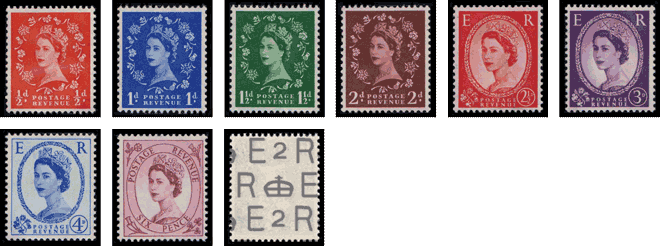
The first stamps of the reign were based on a photograph of the Queen by Dorothy Wilding. This style, using a three-quarter face, was used for King George V “Downey Heads”, but the “Wildings” were more successful, lasting until the introduction of the “Machins” in 1967.
The first Wilding stamps were issued in December 1952, and rolls containing these stamps were issued as stocks of King George VI rolls were exhausted, starting with the (J) roll in March 1954. The full set of 27 rolls from the previous reign were produced with each of the three watermarks of the period, with the following exceptions:
• Tudor Crown: no (A) or (B) rolls as there was sufficient stock of King George VI rolls.
• St. Edward’s Crown: 3d (U) rolls replaced 2½d (U) rolls, keeping the same letter.
• Crowns: roll (K) was discontinued; (AC) and (AD) rolls were introduced.
Stamps with graphite lines were introduced in 1957 as an experiment in Automatic Letter Facing (ALF). There were two lines per stamp, with a single line on the 2d value for the printed paper rate. The lines were 1/32″ (0.8 mm) wide and applied to the back of the paper before applying gum.
Stamps with phosphor bands were introduced in 1960. The lines were initially 5/16″ (8 mm) wide, later widened to 3/8″ (9.5 mm), and applied to the front of the stamps. Three types of phosphor were used, known as green, blue, and violet.
All stamps issued in rolls of this reign were printed in photogravure by Harrison.
To see details of Wilding cylinders and sheet layout click here.
First Issue — Tudor Crown
No (A) or (B) rolls were produced as there was sufficient stock of King George VI rolls in hand.
| AA | ½d | 240 | 10/- | Lower End | Orange/White | c |
| AB | 1d | 240 | £1 | Lower End | Blue/White | c |
| C | 3d | 960 | £12 | Lower End | Buff | 20 † |
| D | ½d | 960 | £2 | Lower End | Orange/White | c |
| E | 1d | 480 | £2 | Lower End | Blue/White | c |
| F | 2½d | 960 | £10 | Lower End | Red/White | c * |
| G | ½d | 480 | £1 | Lower End | Orange/White | c |
| H | 4d | 480 | £8 | Left Side | Buff | 12 |
| J | 6d | 480 | £12 | Lower End | Pink | 20 |
| K | 1½d | 960 | £6 | Lower End | Green/White | c |
| L | 1½d | 480 | £3 | Top End | Green/White | c |
| M | 2½d | 480 | £5 | Left Side | Buff | csw * |
| N | 1½d | 480 | £3 | Left Side | Green/Buff | csw ‡ |
| O | 1d | 480 | £2 | Left Side | Blue/White | 12 |
| P | ½d | 480 | £1 | Left Side | Orange/White | 12 |
| Q | 2d | 960 | £8 | Lower End | Buff | c |
| R | 2d | 480 | £4 | Top End | Brown/White | c |
| S | 3d | 480 | £6 | Left Side | Buff | 12 |
| T | 2d | 480 | £4 | Left Side | Buff | csw |
| U | 2½d | 1,920 | £20 | Lower End | Red/White | c * |
| V | 2d | 960 | £8 | Lower End | Brown/White | c |
| W | ½d | 960 | £2 | Lower End | Orange/White | c |
| X | 1d | 960 | £4 | Lower End | Blue/White | c |
| Y | ½d | 1,920 | £4 | Lower End | Orange/White | c |
| Z | 1d | 1,920 | £8 | Lower End | Blue/White | c |
c: continuous csw: continuous sideways 12/20: strips
* 2½d with Type I diadem.
† first issue with four bands of cross-hatching, second issue with no bands.
‡ first issue green/buff, second issue green throughout.
Stamp Vending Machines
Rolls for use in Post Office vending machines (AA, AB, GEWXYZVU) have 240, 480, 960 or 1,920 stamps wound lengthways, facing inwards, onto ¾” diameter cores, for delivery lower end first.
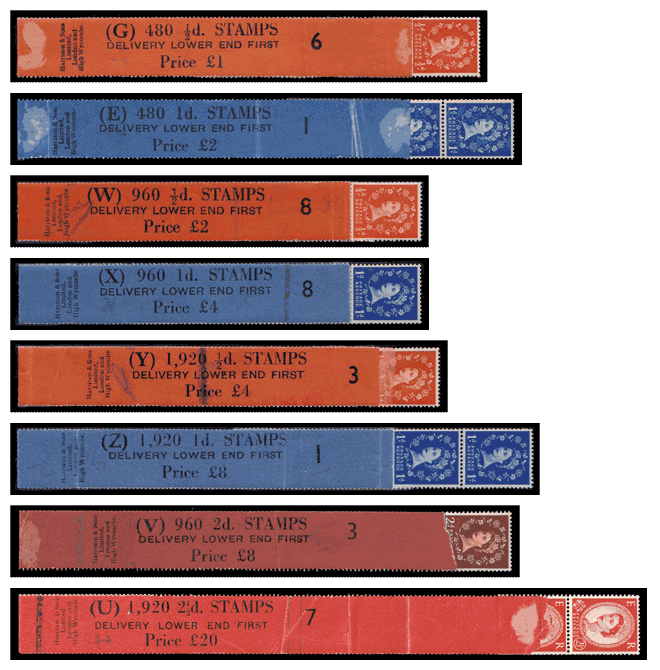
POKO Affixing Machines
Rolls for use in POKO affixing machines (DKQFC) have 960 stamps, or (J) 480 stamps, wound lengthways, facing outwards, onto 1¼” diameter cores, for delivery lower end first.
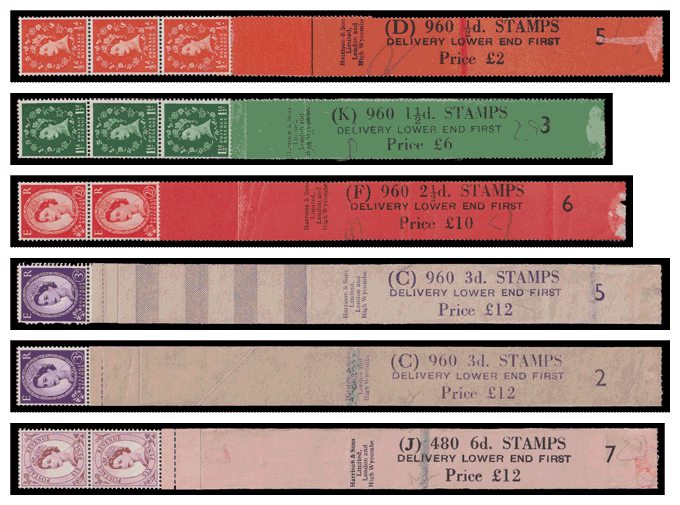
FIXO Affixing Machines
Rolls for use in FIXO affixing machines (LR) have 480 stamps wound lengthways, facing outwards, onto ½” diameter cores, for delivery top end first.

Multipost Affixing Machines
Rolls for use in Multipost affixing machines (PONTMSH) have 480 stamps wound sideways, facing outwards, onto ½” diameter cores, for delivery left side first.
Continuously printed, watermark sideways (NTM):
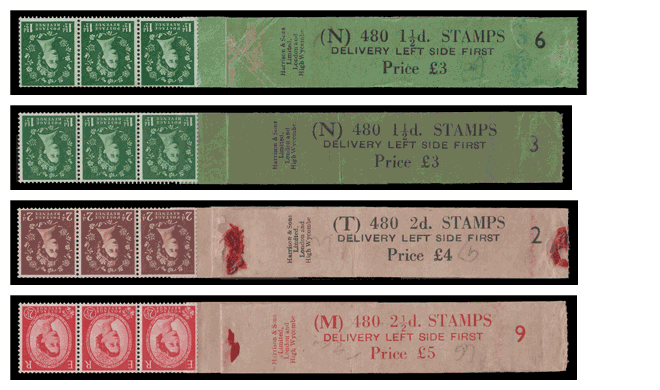
Made from strips of 12, watermark upright (POSH):
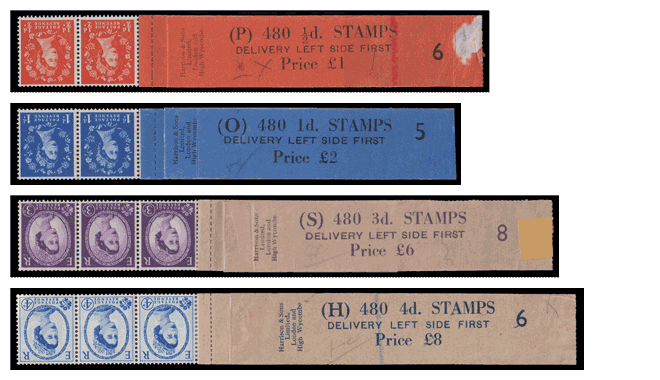
Next: St. Edward’s Crown